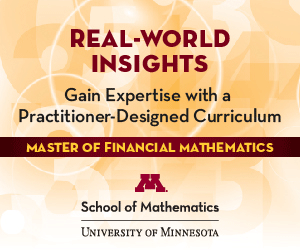- Application deadline
- May 1
The program is designed to prepare students for analytical and technical positions within financial institutions, risk management advisory organizations, and the treasury departments of non-financial corporations.
Robinson’s MRM program is an Accredited University Risk Program of the Professional Risk Managers’ International Association (PRMIA). Students graduating with an MS-MRM will be eligible for exemption from Professional Risk Manager Certification (PRM™) Exams I and II,which form a major part of the certification program by the Professional Risk Managers’ International Association (PRMIA). As part of the program, students will also need to complete FI 8310 Investment Banking or FI 8420 The Financial System, which can be taken as electives.
Core Principles
Robinson’s MRM program is based upon three underlying principles:
Second, in addition to the usual course work found in most financial engineering programs (e.g., stochastic calculus as applied in finance, pricing and hedging redundant securities in continuous and discrete-time settings, basic probability and statistics, etc), the unique aspects of the MRM curriculum that encourage breadth include the following:
Robinson’s MRM program is an Accredited University Risk Program of the Professional Risk Managers’ International Association (PRMIA). Students graduating with an MS-MRM will be eligible for exemption from Professional Risk Manager Certification (PRM™) Exams I and II,which form a major part of the certification program by the Professional Risk Managers’ International Association (PRMIA). As part of the program, students will also need to complete FI 8310 Investment Banking or FI 8420 The Financial System, which can be taken as electives.
Core Principles
Robinson’s MRM program is based upon three underlying principles:
- Quantification of Corporate Risk. The application of mathematics in risk management has been revolutionized in the past 20 years – especially within financial institutions. We believe this quantification of risk will become increasingly central to risk management in all industries.
- Breadth. Significant progress has been made developing models that measure and manage traded market risk and the MRM program provides coverage of these models. However, it is also true firms face a myriad of non-traded risks including risks inherent in the demand and supply for the goods and services, operational risks, and legal and regulatory risks. Many of these risks occur infrequently and, when they do, the complex interactions between the various risk exposures often change potentially accelerating the loss of value for the firm. The MRM program provides rigorous technical training in the mathematical and economic fundamentals so students can develop solutions to difficult risk management problems in a variety of industries – not just application of mathematical methods in finance.
- Integration. It is now accepted that risk management systems should produce net cash flow distributions based on models of both the assets and liabilities of a firm and that these models should be developed simultaneously using a coherent framework to determine the market consistent prices of all cash flows (even when those cash flows are not traded). The MRM program stresses modeling net risk distributions which provides information about the entire risk-return tradeoff and the ability to quantify the costs and benefits of any strategy that alters the risk profile of the firm. In addition, successful integration of the risk management function into the broader corporate mission requires students to recognize the long-term in nature of the “real” assets” needed to produce physical goods and services where there is little opportunity for to “unwind” a position should the future states of the world not move in favorable directions.
What is different about the GSU MRM program?
Second, in addition to the usual course work found in most financial engineering programs (e.g., stochastic calculus as applied in finance, pricing and hedging redundant securities in continuous and discrete-time settings, basic probability and statistics, etc), the unique aspects of the MRM curriculum that encourage breadth include the following:
- Courses from our internationally renowned actuarial science program expose students to the statistical methods used by actuaries and statisticians to measure and manage extreme risk exposures and valuation of non-traded asset classes,
- Custom developed courses that require students build risk management models that integrate both traded and non-traded risks,
- Greater exposure to econometrics and the use of such methods to model consumer behavior
- Greater exposure to corporate finance and corporate risk management functions so students understand the importance of the managerial processes that effectively use this information to formulate corporate strategy and policy.

